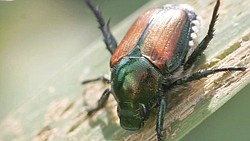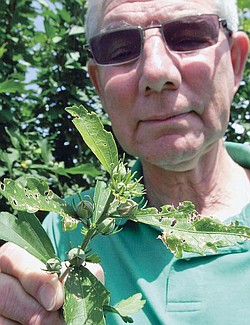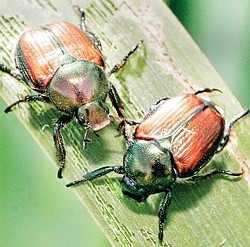Beetle-mania strikes Valley
Gardeners put up with plant pests
By ED RUNYAN
VINDICATOR STAFF WRITER
Japanese Beetles

Japanese Beetle season is here. Steve Hudkins of the OSU Extension explains how to deal with hte pests.
Steve Hudkins, master gardener with OS extension in Cortland shows damage to leaves from Japanese Beetles. wdlewis
A pair of Japanese Beetles feed on an Iris leaf at the OSU extension garden in Cortland.
It’s a good time to be a Japanese beetle but maybe not a good time to be a property owner with flower gardens or rough-edged or red-leafed plants.
For the beetle, it’s mating season and has been for about the past 10 days. It’s a time when the adult beetle emerges from the ground and begins to eat and mate.
It will be a short-lived party for the oval bug with a bright-green and copper-brown hue.
Within about three weeks, most of the beetles will be dead — though some remain later — and their offspring will be in the ground feeding on turf roots and other vegetation and starting another yearlong cycle.
For the human, the Japanese beetle represents a pest problem. During their five-week spree, the beetles cause a lot of damage to as many as 400 types of broad-leafed plants by eating the tissue between the leaf veins, leaving the leaves to look like a skeleton that soon withers and dies.
Jim Adgate, owner of Adgate Landscaping on Elm Road in Bazetta, said it appears that Japanese beetles prefer to eat trees with red foliage, such as sand cherry and purple-leaf plum trees. But at Adgate’s house, they also bother his birch tree and items from his garden such as eggplant and basil.
Steve Hudkins, an assistant professor at The Ohio State University and agricultural educator at the OSU Extension Service office in Cortland, said Japanese beetles have an “affinity for roses and cannas [a big-leafed flower].”
Hudkins believes the beetles may have come a bit late this year as a result of a cool summer so far. He doesn’t believe they are any worse this year than in recent years.
Keith Kaiser, horticulture director for Mill Creek MetroParks and Fellows Riverside Gardens, agrees that roses are among the primary targets of Japanese beetles, in part because so many people grow them, but he also lists the contorted filbert and the perennial hibiscus.
Kaiser said Fellows has used a product called milky spore for about 20 years, and it has diminished the incidence of Japanese beetles in the park. Milky spore is a bacterium that attacks the white grubs of beetles at the immature stage, in the ground.
By attacking the bug at that stage, it becomes unnecessary to combat the Japanese beetle during its adult mating stage, Kaiser said.
For the average homeowner facing a yard full of beetles now, however, milky spore won’t help, Kaiser said. For them, he recommends a bug bag, handpicking them and placing them in a container of water to drown them or using an insecticide such as Sevin.
Kaiser said the old-fashioned remedy of spraying soapy water on them is OK, but he advises against placing them in a can of gasoline to kill them after picking them off of a plant. Plain water works fine, he said.
Hudkins and Adgate agree with the use of an insecticide or removing them by hand. But both say the bug-bag concept is one that you should avoid. A bug bag collects beetles and attracts them with the use of a pheromone tablet. A pheromone is a chemical that serves as a sexual attraction for bugs.
Research has shown that the pheromone can attract a Japanese beetle from a long way away and actually increases damage to the plants near to it, Hudkins said.
Plant experts have joked for years that a bug bag should be placed in the corner of the yard closest to the neighbor you don’t like, Hudkins said, because it’s going to draw the bugs there.
Kaiser said he tried a bug bag last year in his own yard for the first time, and it seemed to help. He’s not sure, but it may have reduced the beetle population in his yard enough to have beneficial effects this year, he said.
Adgate notes that the choice of eliminating Japanese beetles is largely dependent on the personality of the homeowner.
“When someone comes in here and says they want to get rid of Japanese beetles, they generally want to wipe them out,” Adgate said.
For those people, he recommends an insecticide.
But for other people, there are more “green” ways of handling the problem that don’t involve the use of harmful chemicals.
For instance, at his own house, the beetles “devour my birch tree every summer, but it comes back, so it doesn’t bother me,” he said.
For that problem, he does nothing.
“But when they get in the vegetable garden, I have no tolerance there,” Adgate said. For that problem, he usually handpicks them and destroys them under his boot.
At his greenhouse, he cannot sell plants that have leaves damaged by Japanese beetles, so he treats the problem chemically, Adgate said.
runyan@vindy.com
 43
43


